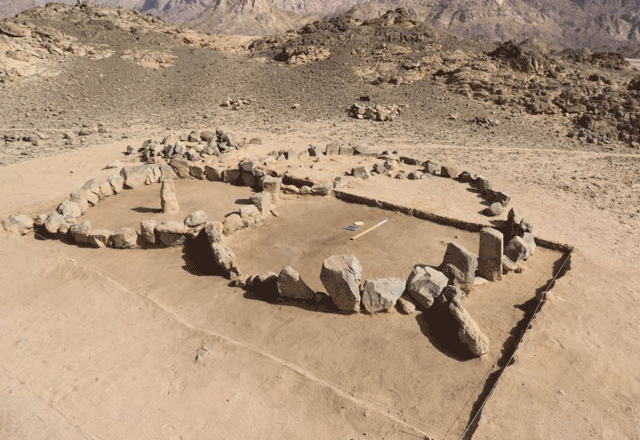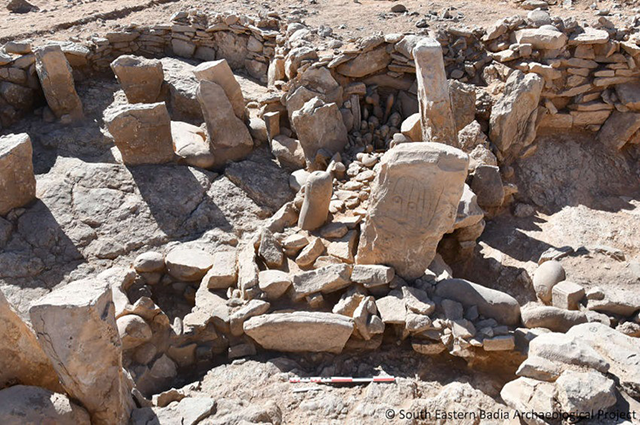You are here
Uncovering prehistoric burial rituals from south-eastern Jordan
By Saeb Rawashdeh - Mar 25,2024 - Last updated at Mar 25,2024

A group of nawamis in the eastern Sinai Peninsula dating from the 1st millennium BC (Photo of Nicky Somerset)
AMMAN — The southeast part of Jordan has not been excavated enough in the past. Despite its remoteness and relative isolation, the south- eastern part of the country provides an abundance of information and artefacts for archaeologists.
For the past couple of years, The South-Eastern Badia Archaeological Project discovered an extensive funerary phenomenon dating back to either the Late Neolithic or a transitional Late Neolithic/ Early Chalcolithic phase. The excavation of a small but representative sample of burial structures highlighted different levels of variability. However, when viewed as a whole, this necropolis on the south-eastern fringe of Jordan demonstrated a marked level of consistency.
“During the Chalcolithic and Early Bronze Age periods, the arid margins of the Southern Levant witnessed an important episode of pastoral nomadic occupation on the edge of the sedentary zone,” noted Wael Abu- Azizeh from the French institute of Middle Eastern studies Ifpo, adding that besides stone enclosures and various structures related to herding and campsites of mobile populations, funerary constructions too are widespread in these desert regions and are believed to represent an important component of a Late Prehistoric pastoral nomadic complex.
“These structures, generically labelled as ‘cairns’, actually encompass a variety of construction types, the exact form of which is often concealed by stone collapse and repeated disturbance by looters,” Abu- Azizeh continued, adding that their common characteristic is, however, their organisation into extensive burial fields, sometime stretching over wide areas of the desert landscape.
Among such mortuary arrangements, the nawamis, corbelled, tower-like constructions of the Sinai are among the most remarkable. These were recognised by early researchers and have been thoroughly investigate.
These tombs provide scholars with rich material, including beads and shells, as well as bones, copper and flint tools.
Gary Rollefson, an American professor emeritus, found similar tower-tomb burials in the Black Desert, in north-eastern Jordan.
“Tumulus fields are a widespread form of funerary construction and they are known in almost every region of the arid margins of the Levant and the Near East, from the Negev and Sinai in the south, through eastern Jordan, northern Syria and the north Arabian Peninsula,” noted Mohammad Tarawneh, stressing that radiocarbon evidence dates these structures to 6th millennium BC.
It has been suggested that the emergence of such cult and mortuary sites was closely related to the growth of caprine herding and the development of pastoral nomadism in these arid region.
Located between Ma’an and Al Mudawwara, the site of Al- Thulaythuwat near Saudi border has been of interest for The South-Eastern Badia Archaeological Project.
The numerous stone enclosures and campsites recorded human presence in these extremely arid areas.
“The presence of a widespread funerary cairn phenomenon along the escarpment ridge of Al Thulaythuwat and its north-eastern extension in adjacent Jabal Kabd is another aspect of the data,” Abu- Azizeh said.
The radiocarbon analysis dates these funerary structures to the Late Neolithic and parallels can be drawn between them and burial structures in the Naqab Desert.
Studying necropolis landscape in the Levant can help understanding of sacred and social dimensions of funerary practices and funerary rituals.
Related Articles
AMMAN — New excavations in Wadi Abu Tulayha help understand the Late Neolithic cultural landscape in southern Jordan, noted a Japanese profe
AMMAN — A research in the south-eastern desert began in 2013 when the “South Eastern Badia Archaeological Project” was established.In a remo
AMMAN — Al Jafr is a town located near Maan, in the south-eastern region of Jordan, within the area of Jibal Khashabiyeh.



















